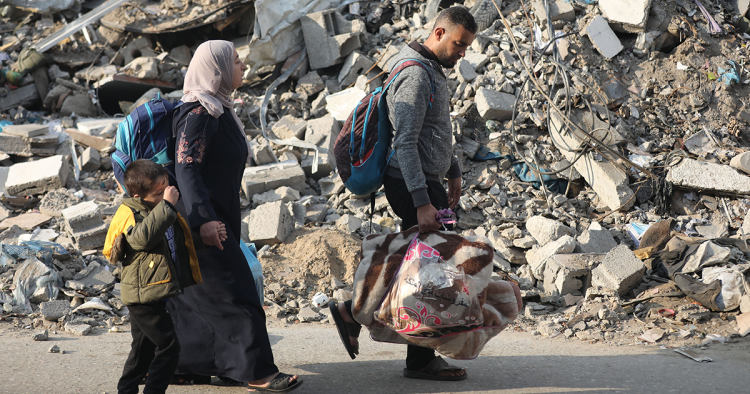The international community is focused on “the day after” in Gaza, built on the comforting but illusory assumption that Oct. 7 never happened. In contrast and notwithstanding their many differences, Israel and Hamas alike are engaged in a zero-sum contest to build a new system for the besieged coastal strip created out of blood and fire.
When we consider the options for Gaza, the most instructive point of departure is the day before — that is, the evolution of Israeli occupation policies in the half century since the June 1967 war.
The centerpiece of Yitzhak Rabin’s winning campaign in 1992 was the promise “to get Gaza out of Tel Aviv” — that is, to keep the largely refugee population of Gaza out of Israel, as laborers and as terrorists in the streets of Tel Aviv and Jaffa.
This popular demand in Israel was a reflection of the broader fact that the system established by Israel to rule Gaza in the aftermath of the June 1967 war was clearly no longer working, certainly not for the almost 2 million Palestinians in Gaza but also — and from Israel’s standpoint most importantly — for Israel.
The heart of the post-1967 war system was the establishment of Israeli civilian settlements in strategic locations throughout Gaza, located in such a way as to balkanize Palestinian areas and so prevent the creation of a cohesive Palestinian territorial unit. The establishment of civilian Jewish settlements also created a politically acceptable rationale for stationing Israeli troops permanently beyond Israel’s borders, that is in Gaza itself. Settlements, security, and an open border with Israel, along with the support offered by Israel to local elements not associated with the Palestine Liberation Organization (PLO), headed by Gaza’s mayor Rashad al-Shawwa, formed the basis of Israel’s “liberal occupation” policies.
This system worked until it failed. Shawaa was deposed in 1981 and the First Intifada erupted in December 1987.
Rabin, to his credit, was not lacking in political imagination. His search for a governing and security structure aimed at consolidating Israeli rule in Gaza, including settlements, centered around a new idea: a partnership with the heretofore dreaded PLO.
Israel leaders were sanguine about the prospects for such a collaboration.
The recently released protocol of the cabinet meeting convened to discuss the Declaration of Principles agreed by Israel and the PLO noted a marked lack of enthusiasm.
“I must say it’s possible that the entire deal with the PLO will fall apart and there will be a Hamas-like Iran here,” Foreign Minister Shimon Peres cautioned. “We also have to be careful. There’s no certainty it will last for all the revolts, all the begging, all the pressure, and everything else. I say this is a very serious matter. I simply don’t see an alternative in the Arab street [to the PLO].”
The Oslo Accords demonstrated that Israel was prepared to establish a new orthodoxy for cementing its rule over Gaza (and indeed the West Bank), centering upon collaboration with the PLO, the Israel Defense Forces (IDF), and settlements.
Yasser Arafat, however, never managed to fulfill the security expectations demanded by Israel. Indeed, the Second Intifada was viewed by Rabin’s successors, principally Ariel Sharon, as proof that the PLO was not a partner, even an adversarial one, but rather an enemy that could never again be trusted to fulfill Israel’s security demands in the West Bank or Gaza.
Sharon, like Rabin, proved that Israeli policy toward Gaza, while strategically consistent, was capable of being tactically imaginative. Sharon’s redeployment from Gaza broke taboos — removing Israeli settlements in Gaza and their 7,000 inhabitants, and thus stripping the IDF of a politically acceptable rational for its deployment there.
Sharon sought to terminate Israel’s responsibilities as the occupying power in the Gaza Strip, and thus end any Israeli responsibility for the welfare of its inhabitants.
He sought to transform Gaza into a foreign country for which Israel had no interest or responsibility — a claim Sharon’s own foreign ministry disputed. As long as Israel remained in “effective control” of the Gaza envelope, it argued, Israel could not claim to have ended its status as the occupying power.
Yet when this system failed on Oct. 7, Israel, with support in Washington and elsewhere, battled Gaza not as an occupying power but as a sovereign protecting itself according to the rules of war.
As the international community considers how best to restore a political dialogue between Israel and the PLO, Israel is creating facts on the ground in an altogether different direction.
Israel today is building a new map of the Gaza Strip, and as was the case in the past the international community, including the United States, is having trouble catching up to the new realities that the Israeli army is now imposing in Gaza.
This disconnect between Israeli intentions and international expectations — concerning the historical treatment of refugees and the establishment of West Bank settlements, for example — is old as the state of Israel itself.
What does the new Gaza look like?
The government of Benjamin Netanyahu, with broad popular support, is determined to exact a cost for the losses suffered on Oct. 7. Revenge is a poor inspiration for politicians and warfighters, but how else to explain the extraordinary damage in lives and property exacted against Gaza?
Indeed, making Gaza uninhabitable, so far in its northern half, is not only a political goal but a military objective as well.
This campaign is consistent with the second, ironclad rule of Israel’s century-old campaign against Palestine: A territorial price must be exacted for any Palestinian attempt to alter the territorial status quo. Hamas will be punished for its sins to be sure, but so too will Palestinians generally, who, among other consequences, will lose control over part of what little is left of their national patrimony.
For Gaza this means that Israel will construct a sterile envelope inside the strip — along Gaza’s northern and eastern border with Israel. It is intended that those who find their land, livelihood, or homes within this envelop should suffer the consequences of Israel’s new security demands.
The IDF will no longer rule Gaza at a remove, as it has done since its September 2005 redeployment. After Oct. 7, Israeli military forces will control Gaza from within Gaza itself, as it did from 1967 to 2005.
Indeed, the rudiments of this new system have already been established. New checkpoints sever Gaza’s northern half from its south and prevent refugees from returning to their homes. No doubt military bases will be re-established, probably on lands where the IDF was deployed until 2005, in the Katif bloc and elsewhere.
One consequence of Israel’s pursuit of unchallenged security control of the entire Gaza Strip is a permanent campaign to destroy the national and security institutions of Hamas.
There is as yet no Palestinian partner for a “Made in Israel” security system, which one senior West Bank Palestinian security official described as making all of the Gaza Strip Area B — an Oslo-era designation of West Bank territory where Israel enjoys overall security control.
Israel has no interest in empowering the PLO in Gaza in any but the most limited governing and policing duties. Fatah remains extremely unpopular while Arab observers report that Hamas retains widespread support. As it did during the first decades of occupation, Israel will look to empower powerful local families and international institutions to manage day-to-day affairs in line with the continuing determination to keep Gaza on a “diet” — the description belongs to a key Sharon advisor, Dov Weissglas.
Like every solution for Gaza imposed by Israel, this new paradigm too will work … until it fails. Hamas, bruised and battered, but not obliterated, will seek to rise from the ashes.
Geoffrey Aronson is a non-resident scholar at MEI.
Photo by Mustafa Hassona/Anadolu via Getty Images
The Middle East Institute (MEI) is an independent, non-partisan, non-for-profit, educational organization. It does not engage in advocacy and its scholars’ opinions are their own. MEI welcomes financial donations, but retains sole editorial control over its work and its publications reflect only the authors’ views. For a listing of MEI donors, please click here.













